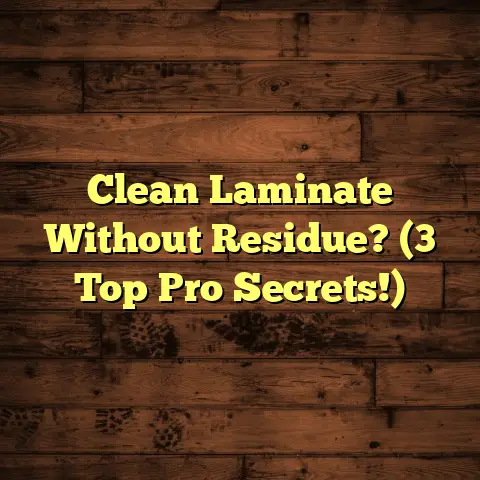Cleaning Natural Stone Tile Floor? (7 Secrets Now!)
What if you could transform your dull and dirty natural stone tile floor into a gleaming masterpiece?
One that not only enhances the beauty of your home but also extends the life of your flooring?
Imagine walking into a room where the floors reflect light like polished gems.
Impressing guests and making your home feel more inviting.
The good news is that achieving this stunning look isn’t just a dream.
It’s entirely possible with the right cleaning techniques and secrets.
As a flooring contractor with years of experience, I’ve seen firsthand the difference proper care can make.
In this article, I’ll unveil seven essential secrets to cleaning and maintaining your natural stone tile floor.
Ensuring it stays beautiful and durable for years to come.
Section 1: Understanding Natural Stone Tile
Natural stone tile is exactly what it sounds like: tile made from natural stone.
Unlike ceramic or porcelain, which are manufactured, natural stone is quarried from the earth.
This gives each tile unique variations in color, pattern, and texture.
Think of it as nature’s own artwork right under your feet!
Common Types of Natural Stone Tile
-
Marble: Known for its luxurious look and veining. It’s relatively soft and porous.
-
Granite: Very durable and resistant to stains. Ideal for high-traffic areas.
-
Slate: Distinctive layered appearance, slip-resistant. Great for rustic or modern designs.
-
Limestone: Earthy tones and a matte finish. More porous than granite.
-
Travertine: Characterized by its pitted holes and swirling patterns. Often used in Mediterranean-style homes.
Unique Characteristics
The beauty of natural stone is also its challenge.
These tiles are porous, meaning they have tiny holes that can absorb liquids and stains.
This is especially true for marble, limestone, and travertine.
They’re also susceptible to damage from acidic cleaners and abrasive materials.
Think lemon juice or scouring pads – a big no-no!
Aesthetic and Practical Benefits
Despite these challenges, natural stone flooring offers timeless appeal and durability.
It adds a touch of elegance and sophistication to any home.
Plus, when properly maintained, it can last for decades.
I’ve seen marble floors in historic buildings that still look stunning after centuries!
Section 2: The Importance of Proper Cleaning
Techniques
Why can’t you just use any old cleaner on natural stone?
Because many traditional cleaning methods can be harmful.
Acidic cleaners like vinegar or lemon juice can etch the surface, leaving dull spots.
Abrasive materials like steel wool can scratch the finish.
Trust me, I’ve seen the damage firsthand!
Long-Term Benefits
Using the right cleaning techniques and products preserves the integrity and appearance of your tiles.
It prevents staining, etching, and scratching.
Extending the life of your flooring.
Think of it as an investment in your home’s value and beauty.
Expert Opinions and Statistics
According to the National Stone Institute, proper maintenance can significantly extend the life of natural stone flooring.
They recommend using pH-neutral cleaners and sealers to protect the stone.
I’ve also seen studies showing that homes with well-maintained natural stone floors have higher resale values.
It’s a win-win!
Section 3: Secret #1 – Regular Sweeping and
Dusting
The first secret is simple but crucial: regular sweeping and dusting.
This prevents dirt and debris from building up.
Which can scratch the surface of your tiles over time.
Think of it like this: dirt is like sandpaper under your feet!
Step-by-Step Instructions
-
Sweep or dust your floors at least once a week, or more often in high-traffic areas.
-
Use a soft-bristle broom or a microfiber dust mop.
-
Pay attention to corners and edges where dirt tends to accumulate.
-
Consider using a vacuum cleaner with a soft brush attachment.
But be careful not to scratch the surface.
Recommended Tools
-
Microfiber Mops: These are great for attracting dust and dirt without scratching.
-
Soft-Bristle Brooms: Choose a broom with natural or synthetic bristles that are gentle on stone.
-
Vacuum Cleaners with Brush Attachments: Make sure the brush is soft and clean.
I always tell my clients to invest in quality tools.
It makes the job easier and protects your floors.
Section 4: Secret #2 – Choosing the Right
Cleaning Solution
Not all cleaning solutions are created equal.
Especially when it comes to natural stone.
You need to choose a cleaner that’s safe and effective.
Safe Cleaning Solutions
The best option is a pH-neutral cleaner.
These cleaners won’t damage the stone or alter its color.
Look for products specifically designed for natural stone.
Avoid anything acidic, alkaline, or abrasive.
Recommended Products
-
StoneTech Professional Revitalizer: A popular choice for daily cleaning.
-
MARBLELIFE Marble & Stone Cleaner: Gentle and effective for marble and other delicate stones.
-
Simple Green Stone Cleaner & Polish: A biodegradable option that’s safe for the environment.
DIY Solutions
If you prefer a DIY approach, you can make your own cleaning solution with:
-
Warm Water: The base for any good cleaning solution.
-
Mild Dish Soap: Use a small amount of a gentle, pH-neutral dish soap.
-
Baking Soda Paste: For removing stubborn stains.
But use it sparingly and rinse thoroughly.
Testing Your Solution
Before applying any cleaning solution to your entire floor, test it on a small, inconspicuous area.
This will ensure that it doesn’t damage or discolor the stone.
I always recommend testing in a closet or under a rug.
Section 5: Secret #3 – The Power of Water and
pH Balance
Water temperature and pH balance play a crucial role in the cleaning process.
Using the wrong water or a solution that’s too acidic or alkaline can damage your stone.
Ideal Water Temperature
Warm water is generally best for cleaning natural stone.
It helps to dissolve dirt and grime without being too harsh.
Avoid using hot water, as it can strip away sealers and damage the stone over time.
Distilled Water
For optimal results, consider using distilled water.
It’s free of minerals and impurities that can leave streaks or spots on your floor.
I’ve seen a noticeable difference in the shine and clarity of floors cleaned with distilled water.
Maintaining pH Balance
pH is a measure of how acidic or alkaline a substance is.
A pH of 7 is neutral, below 7 is acidic, and above 7 is alkaline.
Natural stone is generally best cleaned with a pH-neutral solution (around 7).
Acidic cleaners (like vinegar) can etch the stone.
While alkaline cleaners (like bleach) can cause discoloration.
Section 6: Secret #4 – Effective Mopping
Techniques
Mopping is an essential part of keeping your natural stone floors clean.
But it’s important to do it correctly to avoid damage.
Step-by-Step Mopping Instructions
-
Prepare your cleaning solution: Mix your pH-neutral cleaner with warm water according to the product instructions.
-
Dampen your mop: Wring out the mop thoroughly so that it’s damp, not soaking wet.
-
Mop in sections: Work in small sections, overlapping each stroke.
-
Rinse the mop frequently: Rinse the mop in clean water after each section to avoid spreading dirt.
-
Dry the floor: Use a clean, dry towel or microfiber cloth to dry the floor immediately after mopping.
This will prevent water spots and streaks.
Damp vs. Soaking
It’s crucial to use a damp mop rather than soaking the floor.
Excess water can seep into the stone and cause staining or damage.
I’ve seen floors ruined by homeowners who simply dumped water on them!
Best Mop Types
-
Microfiber Mops: These are gentle, absorbent, and easy to clean.
-
Sponge Mops: Choose a sponge mop with a soft, non-abrasive sponge.
-
String Mops: These can be effective, but make sure to wring them out thoroughly.
Section 7: Secret #5 – Stain Removal
Strategies
Stains are inevitable, but they don’t have to be permanent.
Knowing how to tackle common stains can save your natural stone floor from lasting damage.
Common Stains and How to Tackle Them
-
Oil Stains: These can be removed with a poultice made of baking soda and water. Apply the paste to the stain, cover with plastic wrap, and let it sit for 24 hours. Then, remove the plastic wrap and let the paste dry completely. Finally, scrape off the dried paste and rinse with water.
-
Wine Stains: These can be removed with a solution of hydrogen peroxide and water. Apply the solution to the stain, let it sit for a few minutes, and then blot with a clean cloth.
-
Hard Water Stains: These can be removed with a solution of white vinegar and water. Apply the solution to the stain, let it sit for a few minutes, and then scrub with a soft brush. Rinse with water and dry thoroughly.
Recommended Products
-
StoneTech Oil Stain Remover: Designed specifically for removing oil-based stains from natural stone.
-
MARBLELIFE Stain Remover: Effective for a variety of stains, including wine, coffee, and tea.
Preventive Measures
-
Use Doormats: Place doormats at entrances to trap dirt and debris before they reach your floors.
-
Clean Spills Immediately: Wipe up spills as soon as they happen to prevent staining.
-
Use Coasters and Placemats: Protect your floors from spills and stains by using coasters and placemats under drinks and food.
Section 8: Secret #6 – Sealing Your Natural
Stone Floor
Sealing your natural stone tiles is crucial for protecting them from stains and moisture.
A good sealer will penetrate the stone and create a barrier that prevents liquids from seeping in.
Types of Sealers
-
Penetrating Sealers: These sealers penetrate the stone and fill the pores, providing protection from within.
-
Topical Sealers: These sealers create a protective layer on the surface of the stone.
They can provide a glossy or matte finish.
When to Apply
You should seal your natural stone floor when it’s newly installed and then reapply the sealer every 1-3 years, depending on the type of stone and the level of traffic.
I always tell my clients to follow the manufacturer’s instructions for the specific sealer they’re using.
Step-by-Step Sealing Guide
-
Clean the floor: Make sure the floor is clean and dry before applying the sealer.
-
Apply the sealer: Use a clean mop, brush, or applicator to apply the sealer evenly to the floor.
-
Let it penetrate: Allow the sealer to penetrate the stone for the recommended amount of time.
-
Wipe off excess: Use a clean cloth to wipe off any excess sealer from the surface of the stone.
-
Let it cure: Allow the sealer to cure for the recommended amount of time before walking on the floor.
Section 9: Secret #7 – Engaging Professional
Help When Necessary
Sometimes, despite your best efforts, you may need to call in a professional cleaning service.
They have the expertise and equipment to tackle tough stains and restore your natural stone floors to their former glory.
When to Hire a Professional
-
Stubborn Stains: If you’ve tried everything and can’t remove a stain, it’s time to call a pro.
-
Extensive Damage: If your floors are heavily scratched, etched, or damaged, a professional can restore them.
-
Lack of Time: If you simply don’t have the time or energy to clean and maintain your floors, a professional can take care of it for you.
What to Look For
-
Experience: Choose a company with experience cleaning and restoring natural stone floors.
-
Reputation: Check online reviews and ask for references.
-
Insurance: Make sure the company is insured in case of accidents or damage.
Questions to Ask
-
What cleaning methods do you use?
-
What products do you use?
-
Do you offer a guarantee?
Costs vs. Benefits
Professional cleaning can be expensive.
But it can also save you time, effort, and potentially the cost of replacing your floors.
I always recommend getting a few quotes and comparing prices before making a decision.
Conclusion:
Properly cleaning and maintaining natural stone tile floors can transform your home.
Making it more beautiful and inviting.
By implementing the seven secrets I’ve shared in this article.
You can achieve and sustain the beauty of your flooring for years to come.
Remember, a little care and the right techniques can make all the difference.
Your natural stone tiles can remain stunning and resilient for years.





